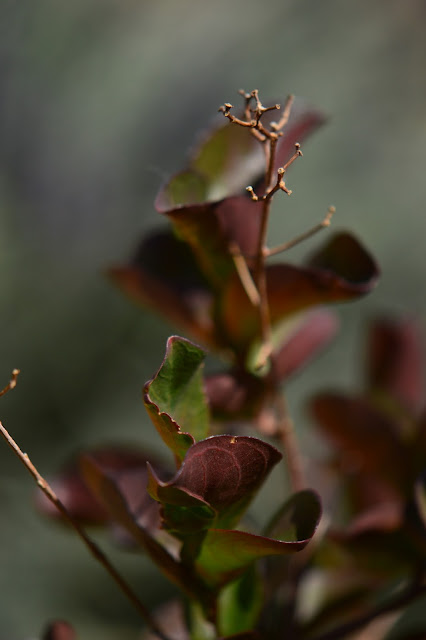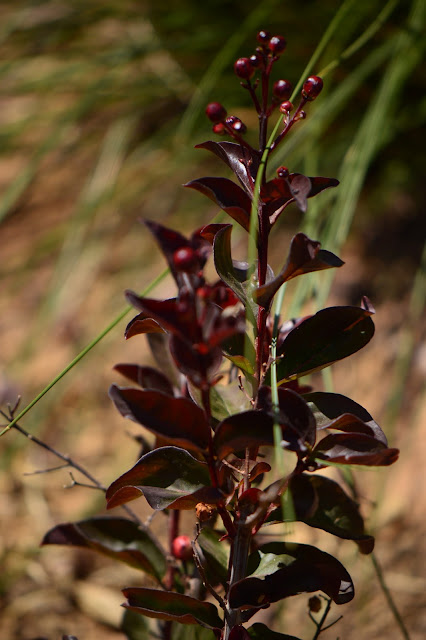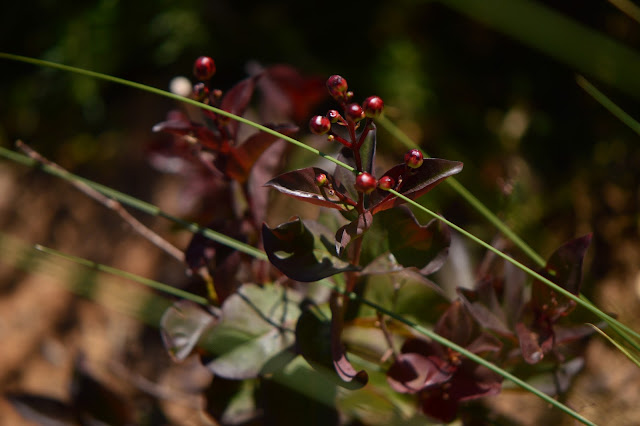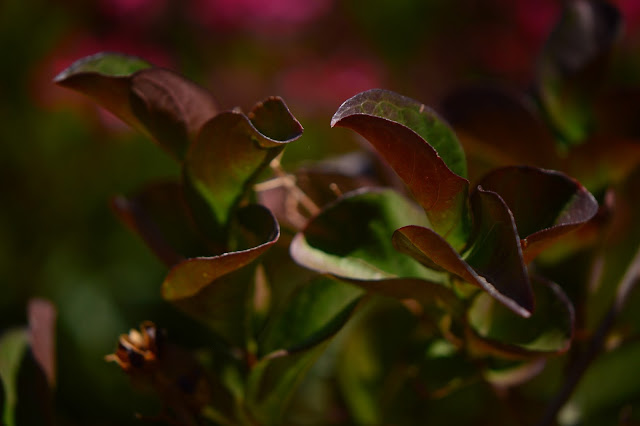It has been a curious process, readjusting to the presence of winter-deciduous plants in this garden. All the more so, since my earlier garden contained few evergreens of any sort, and the leafing-out of springtime was one of its most characteristic pleasures.
But the whole thing looks a good deal different in a garden where many plants do not change much from month to month: a falling-off of bloom or even foliage in summer and, if anything, a burst of new growth in winter. A very few plants die back for the cool season to emerge again in spring. Many make the most of the cooler weather by putting forth their best by February at the latest.
The result was a very anxious gardener hovering over three most-definitely deciduous plants: structural plants at that, which I am depending on to eventually provide height year-round and much-needed shade during summer. The plants in question are two crape myrtles (Lagerstroemia indica "Rhapsody in Pink" and "Dynamite") and one desert willow (Chilopsis linearis "Lucretia Hamilton"). I checked daily at least for the better part of February and some of March. Looking at those dry branches, wondering where -- or indeed, whether -- new buds would break on the stems. I am not familiar with the habits of these plants so I looked for any little signs of sap rising, pushing out the tiny leaves. I worried that I had been careless during our relatively dry winter, not providing moisture often enough to sustain the youngsters!
But at last, they all three poked out a few tips, then came into full leaf. The Chilopsis was the last to show any signs of life; and, with the rest of the garden in full spring bloom, I really did have my doubts until a drive around town showed me that many mature desert willows still had no green either. So, for the record, it seems that Chilopsis tends to break dormancy only in mid-spring.
I have no pictures of the Chilopsis. Although looking healthy, it is still only about 10 inches high, with one main tuft of its long leaves sprouting round the tiny stem.
But the Lagerstroemias are larger and, making up for winter's bare branches, are worth looking at right now for their burgundy-coloured new growth.
On "Dynamite" this is beginning to have shadings of green in the older leaves...
...which wrap the stems up to where last year's seedpods fell from a few branch tips.
"Rhapsody in Pink", which leafed out later and still shows little green in its striking foliage colour...
...is ahead in other ways. It is already setting buds, which may well open by next month. (Yes, it is still quite small itself, and those are grass stems shooting across the photo! But in a few years, if all goes well, it will overhang the Muhlenbergia beside it.)
Lagerstroemias are known to produce a nice touch of autumn colour even in mild climates, where it is hard to come by. I did not realize they would add such a wonderful, deep-toned accent in spring.
Thanks to Christina of My Hesperides Garden for encouraging us to look at what foliage contributes to the garden each month!
Weather Diary: Sunny and breezy; High: 96 F (36 C)/Low: 69 F (21 C)







I have to say your Lagerstroemias look a great deal happier than mine. Mine struggle with the summer drought here. The best ones I've seen were in North Carolina where although it was very hot it was also humid, I think they need that humidity, so good luck with yours. Thanks for joining GBFD this month with a very interesting post.
ReplyDeleteThank you, Christina - glad to finally join in again as I've managed to miss a couple times already this year.
DeleteA note on the crape myrtles: I have nothing to compare them to as Lagerstroemias were only marginally hardy in my previous garden and I never tried them there. But I do note that both these selections come from Dr. Carl Whitcomb's breeding program, which has produced a number of selections noted for excellent drought-tolerance, unlike so many other varieties. "Dynamite" (WHIT II) in particular is recommended for high drought-tolerance, as are some of his other introductions (WHIT III, WHIT IV). Granted, drought in Dr. Whitcomb's Oklahoma is still more humid than here, but both my plants came through last summer more or less smiling. His selections tend to have a number of excellent characteristics, including a much-longer bloom season and the intense spring colour I am enjoying just now...
My crape myrtle cutting is a few inches high with a bunch of leaves.
ReplyDeleteSounds as if I can expect it to be happier with moist sea breezes.
They certainly seem to prefer some moisture, Diana! And salt tolerance must be reasonably good, or they wouldn't be growing here...
DeleteThe crepe myrtle foliage is worth waiting for! I'd still like to find room for one in my own garden.
ReplyDeleteIt certainly is, Kris! And after looking at the Nat. Arboretum site, I've decided I couldn't have chosen better if I'd researched the varieties. As I noted in my reply to Christina, the Whitcomb selections seem to be excellent prospects for drought-tolerance, and many have good mildew-resistance too. Of course, that's if you can find room...! ;-)
DeleteJust in case you're interested, here is the link that includes these particular varieties -- I found it helpful: http://www.usna.usda.gov/Research/Herbarium/Lagerstroemia/Checklist_W.html
I love the rich, deep red of these crape myrtles and it sounds as if they may thrive here with sea breezes and quite dry soil - I will invetsigate more!
ReplyDeleteSo glad you enjoyed these, Ann! Sadly, I believe crape myrtles require a good deal of heat to flower well; that might be a limiting factor, although they are lovely plants for foliage and bark in any case!
DeleteBeautiful foliage Amy! I love that Crape Myrtle - I don't think I have ever seen one before with such a lovely color to the leaves. We have them here and they are very beautiful but one with burgundy leaves would be stunning!
ReplyDeleteCrape Myrtles must grow beautifully there - must be heavenly during bloom season! They are used here, but not in large quantity. I was so pleased to find I could use them, though. The first variety, "Rhapsody in Pink", is said to hold its deep burgundy foliage through the season, which will be a real treat in the border.
Delete